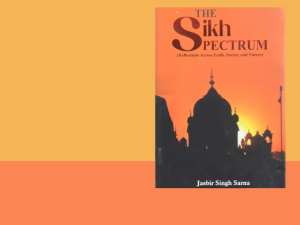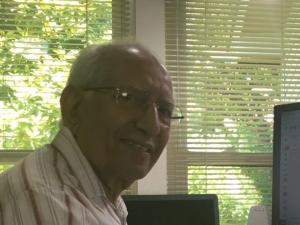Sir William James, an American philosopher and psychologist, eloquently described in his writings that every human is born with an innate urge to know something higher. We often call that higher entity God. But we have never been able to comprehend or even describe that higher entity intelligently, even though we devised several beliefs in God, deities, religions, etc.
The Sikh theologian of the Gurus’ era Bhai Gurdas described the innante urge and its ill-conceived human solution in the following way:
ਲਖ ਚਉਰਾਸੀਹ ਜੋਨ ਵਿਚ ਮਾਨਸ ਜਨਮ ਦੁਲੰਭ ਉਪਾਯਾ॥
ਚਾਰ ਵਰਨ ਚਾਰ ਮਜ਼ਹਬਾ ਹਿੰਦੂ ਮੁਸਲਮਾਨ ਸਦਾਯਾ॥
ਕਿਤੜੇ ਪੁਰਖ ਵਖਾਣੀਅਨ ਨਾਰ ਸੁਮਾਰ ਅਗਨਤ ਗਣਾਯਾ॥
ਤ੍ਰੈ ਗੁਨ ਮਾਯਾ ਚਲਤੁ ਹੈ ਬ੍ਰਹਮਾ ਬਿਸਨ ਮਹੇਸ ਰਚਾਯਾ॥
ਬੇਦ ਕਤੇਬਾਂ ਵਾਚਦੇ ਇਕ ਸਾਹਿਬ ਦੁਇ ਰਾਹ ਚਲਾਯਾ॥
ਸ਼ਿਵ ਸ਼ਕਤੀ ਵਿਚ ਖੇਲ ਕਰ ਜੋਗ ਭੋਗ ਬਹੁ ਚਲਿਤ ਬਣਾਯਾ॥
ਸਾਧ ਅਸਾਧ ਸੰਗਤ ਫਲ ਪਾਯਾ ॥
– Bhai Gurdas, Vaar 8, Pauri 6
Out of numerous life-forms evolved the hard-to-obtain human being – who invented many divisions, stratifications of society, and religions; and labeled themselves Hindus or Muslims.
Countless of the human creation discriminated themselves into males and females. Further, this world became a fraudulent display of the illusion of Maya, which created Brahma, Vishnu, and Mahesh. Hindus read Vedas and Muslim read Islamic scriptures, resulting in two different ways to describe one Creator.
Out of the play of Siva-Sakti, (i.e., Maya – the intellect of illusions) were propagated benefits from yoga (meditations through body exercises) and bhoga (sensual enjoyment). Both genuine and pretentious clergy reaped the fruit.
Until Guru Nanak came to this world, both Abrahamic and Dharma religions described God as an anthropomorphic entity (the description of God in physical human terms, categories, or forms appropriate to His Majesty). People of the time viewed their anthropomorphic God through the texts of the Vedas, the Hebrew Bible, the New Testament, and the Holy Qur’an.
Further, the anthropomorphic doctrine came to believe that God, once created by humans, in turn, made humans in His moral image. It meant that God wished humanity to live a life marked by justice, equality, fair dealing, mutual respect, sympathy, love, compassion, charity, etc. Indeed, the children of Abraham (the Semitic consciousness) and Vedic civilization so personalized, rationalized, and anthropomorphized the transcendental Deity that in effect, it became just a larger, more powerful, and lethal version of themselves.
As such, humanity did not hesitate to impart onto God its varied individual, communal and national agendas, practices, ideas, likes and dislikes, etc., to create an absolute out of finite ideas of nationhood, ethnicity, race, polity, ideology, and even theology.
We call an anthropomorphic God a God concocted by clergy.
This clergy-created God sits faraway in the heavens as a majestic human figure micromanaging human affairs. Our houses of worship told us that humans must fear this God; otherwise, He will dish out punishments like pain, disease, and calamities; and after death we will live like suffering animals. Further, this God had to be searched and venerated. This God needed appeasement through clergy intermediaries.
As a consequence, a variety of religious dogma, beliefs, and practices were invented. For example: endlessly repeating names, regurgitating scriptures, and gifting part of our possessions to the clergy. The clergy also invented a variety of religious institutions to their advantage.
Five centuries ago Guru Nanak began his mission by alerting people against this clergy-made God. Instead, he preached God as a virtual reality in all creation. Thus, the God of Guru Nanak is associated with and realized through a genuine appreciation of the natural designs that flourish within and around us.
Guru Nanak depicted his God through an icon, ੴ, pronounced as Ek ongkar. Nanak prescribed a meditation on this icon along with the meaning behind it.
We may describe Guru Nanak’s Icon ੴ literary to mean the One Virtual Reality manifested in numerous ways throughout all creations. Guru Nanak described this icon in his own words as:
ਅਨਿਕ ਭਾਂਤਿ ਹੋਇ ਪਸਰਿਆ ਨਾਨਕ ਏਕੰਕਾਰੁ ॥ SGGS, p. 296.
Ek Onkar manifests in creation in so many ways, says Nanak.
Guru Nanak advised that we perceive and connect with that higher entity through its manifestation in creation and consume its virtues within us to become human beings.
Then Guru Nanak selected some of those virtues to inculcate upon with a purpose to lift ourselves to a god-like way of life. Through the practice of these virtues, Guru Nanak brought in a metamorphosis that transformed humans into gods.
The dictionary describes metamorphosis as a change in the form or the nature of a living entity, transforming that entity into an entirely distinct entity by natural or supernatural processes. When it’s done right, it is like a caterpillar turning into a butterfly. The transformation of a human into a god-like entity is the kind of metamorphosis promised by the teaching of Guru Nanak.
To describe and appreciate such a metamorphosis, Guru Nanak wrote,
ਬਲਿਹਾਰੀ ਗੁਰ ਆਪਣੇ ਦਿਉਹਾੜੀ ਸਦ ਵਾਰ ॥ ਜਿਨਿ ਮਾਣਸ ਤੇ ਦੇਵਤੇ ਕੀਏ ਕਰਤ ਨ ਲਾਗੀ ਵਾਰ ॥ SGGS, p. 462.
I am a sacrifice to my Guru (enlightener) a hundred times a day as my Guru makes angels out of humans and bypassing all delaying ploys.
To further illustrate the heightened image of a metamorphosis, the Guru Granth gives the example of a goldsmith who makes a jewel out of an ordinary metal.
ਲੋਹਉ ਹੋਯਉ ਲਾਲੁ ਨਦਰਿ ਸਤਿਗੁਰੁ ਜਦਿ ਧਾਰੈ ॥ SGGS, p. 1399.
Iron is transformed into a gemstone when the True Guru bestows His Vision of Spirituality on the seeker.
Guru Nanak further said that only the Ek Onkar remains to realize when one wishes to resolve doubts. When all doubts are extinguished, one attains a metamorphosis.
ਭ੍ਰਮ ਛੂਟੇ ਤੇ ਏਕੰਕਾਰ ॥੩॥ SGGS, p. 736.
When we get rid of all impeding doubts, what remains is the spirituality of Ek Onkaar.
Relevant to human life, its inter-relationships, and its practices, Guru Nanak further highlighted that Ek Onkar dwells within each heart for a twofold purpose. The first is to learn the Divine Virtus, and the second is to lead the wisdom-oriented person towards inculcating the divine virtues within the human mind as human consciousness.
ਕਾਇਆ ਅੰਦਰਿ ਆਪੇ ਵਸੈ ਅਲਖੁ ਨ ਲਖਿਆ ਜਾਈ ॥ SGGS,p.754
The Divine dwells within the body; It is invisible and may not be realized.
ਕਾਇਆ ਅੰਦਰਿ ਜਗਜੀਵਨ ਦਾਤਾ ਵਸੈ ਸਭਨਾ ਕਰੇ ਪ੍ਰਤਿਪਾਲਾ ॥ SGGS, p.754
The Life of the World, the Great Giver Divine, dwells within the body; It is the custodian of all.
Guru Nanak’s purpose of stressing the Divine was to lead his followers towards life’s real goal. The aim was to realize and instill the Divine within. He elected to include in Guru Granth:
ਮਨ ਤੂੰ ਜੋਤਿ ਸਰੂਪੁ ਹੈ ਆਪਣਾ ਮੂਲੁ ਪਛਾਣੁ ॥ SGGS, p. 440
O my mind, you are the embodiment of the Divine Light – recognize your bases.
Then, the purpose was to emulate God by living a life that actively expressed divine attributes in everyday expressions, resulting in the desired human actions. Towards this end, Guru wrote.
ਗੁਣ ਸੰਗ੍ਰਹਿ ਪ੍ਰਭੁ ਰਿਦੈ ਨਿਵਾਸੀ ਭਗਤਿ ਰਤੀ ਹਰਖਾਈ ॥ SGGS p. 1273
The seeker enshrines God within her heart and thereby gathers divine virtues imbued with devotion and achieves contentment.
Further, Guru Granth explains that a person of God must be like a god.
ਹਰਿ ਜਨੁ ਐਸਾ ਚਾਹੀਐ ਜੈਸਾ ਹਰਿ ਹੀ ਹੋਇ ॥ SGGS, p. 1372
The humble servant of God should be just like God.
There are fourteen hundred and twenty-nine pages of the sacred scripture, the Sri Guru Granth Sahib that elaborate Guru Nanak’s teachings about God and relate to God.
However, through an inaugurating verse in the Sikh scripture, the Guru Granth, Guru Nanak, highlighted specific characteristics or virtues of Divine suitable for humans to inculcate within the human intellect. Uniquely, Guru Nanak’s inaugural verse begins with the numeral of One is:
ੴ ਸਤਿ ਨਾਮੁ ਕਰਤਾ ਪੁਰਖੁ ਨਿਰਭਉ ਨਿਰਵੈਰੁ ਅਕਾਲ ਮੂਰਤਿ ਅਜੂਨੀ ਸੈਭੰ ਗੁਰ ਪ੍ਰਸਾਦਿ ॥ SGGS, p. 1.
The translation of the above verse in terms of the divine virtues is as they are listed below.
The poem starts with Guru Nanak’s designated icon ੴ, followed by the virtues chosen for emulation of countless divine virtues. The icon translated as: God is one virtual reality manifested in all creations: God’s presence within the human heart bestows numerous virtues. However, the virtues that Guru Nanak chose for the metamorphosis of the human mind are:
- Recognize Your True Eternal Identity and become Truthful!
- Cultivate a Creative Personality!
- Emit Fearless Behaviors!
- Consider No One As Your Enemy!
- Engage In Timeless Actions!
- Let No Impact Of Anthropomorphism!
- Cultivate The Eternal Self!
- Be Grateful to The Eternal Wisdom
Indeed, the above attributes of God instilled in humans will bring a metamorphosis of humans into gods.
~~~~~~~~~~~~~~~~~~~~~~~~~~~~~
Send all communications to:
Harbans Lal, Ph.D.; D.Litt (Hons)
Professor Emeritus & Chairman, Dept of Pharmacology & Neurosciences, University of North Texas Health Science Center.
Professor Emeritus, Guru Nanak Dev University, Amritsar, India.
President, Academy of Guru Granth Studies.
web: https://seekingwisdomblog.wordpress.com
email: Ja[email protected]






